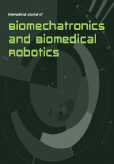International Journal of Biomechatronics and Biomedical Robotics
- Editor in Chief
- Dr. M.A. Dorgham
- ISSN online
- 1757-6806
- ISSN print
- 1757-6792
- 4 issues per year
IJBBR provides a cross-disciplinary platform addressing biomechatronics and robot assistive technologies for medical and bio applications. It relates to the design of systems, devices and products for use as assistive tools when interacting with humans and biosystems. It features practical developments covering a wide range of areas including medical robotics, rehabilitation, assistive technology for the elderly and disabled, robotic surgery aids/systems, operative planning tools, medical imaging/visualisation, simulation/navigation, virtual reality, intuitive command and control systems, haptics and sensor technologies.

 inderscience.com)
inderscience.com)